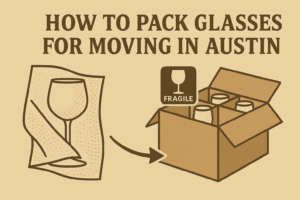
Are you moving soon and have pets? The process of moving can be difficult for humans, so it’s only natural that our furry friends would feel some stress too. Whether it’s a residential or apartment move with a dog, cat, or other small animals, these are the ten pointers from Not A Hobby Moving that will help make the experience as stress-free as possible for you and your pets.
1. Make a list of what you need to pack for your pet
It’s essential to put together a packing list in advance. Start by listing all the essential items your pet needs, such as food, water, bedding, and toys. It’d also help to take an inventory of what you already have and what needs to be purchased. Don’t forget to include any special items your pet may need, such as medication or a calming agent.
Pack everything in an easily accessible spot so you can quickly grab it on moving day. If it’s a long-distance move, consider having your pet’s things shipped ahead of time. This would make it easier for you to pack everything else and not worry about your pet’s things getting lost. Using professional packing services can save you time as well.
2. Label their food and water dishes
Make sure to label your pet’s food and water dishes clearly. Include your pet’s name and your new address. Labeling your pets’ belongings will help ensure they don’t get lost in the move. If you’re using disposable plates, be sure to pack enough for the entire trip. Remember that stressful situations can cause your pet to lose their appetite, so it’s vital to have food and water available.
Assuming you’ll be feeding your pet during the drive, pack some snacks for them as well. Soft, chewy treats are ideal since they won’t make a mess in the car.
If you have a cat, pack their litter box and scoop. You’ll want to have these items close at hand during the move so you can quickly set up their bathroom area. Cats can be particular about their litter boxes, so making them as comfortable as possible is essential.
Dogs need plenty of breaks during the move, so plan your route accordingly. We suggest stopping at least once every two hours to let your dog stretch their legs and relieve itself. If you’re traveling with a puppy, you may need to stop frequently. If you’re unsure about the route, hiring professional Austin movers who know the area well would be your best bet.
Pets can get stressed during a move, so keeping them calm is essential. If possible, have someone stay with your pet while the rest of the family is busy with the moving process.
3. Pack your pet’s favorite toys and blankets
One way to help ease your pet’s anxiety is by packing their favorite toys and blankets. It will help them feel more comfortable in their new surroundings.
— Not A Hobby Moving (@NotAHobbyMoving) October 20, 2022
If you’re moving to a new city, it’s essential to do your research beforehand. Find out where the nearest vet is located, and make sure you have all of your pet’s medical records with you. It’s also a good idea to find out if there are any dog parks or pet-friendly restaurants in your new neighborhood.
Simple tips like this can help make moving easier for your furry friend. And most importantly, don’t forget to give them plenty of love and attention during this time. They deserve it!
4. If you’re traveling by car, try to keep them in the backseat or a crate
If you’re traveling by car, keeping your pet stress-free is keeping them in the backseat or a crate. This will help prevent them from getting under your feet while driving. It can also prevent your pet from becoming anxious or scared if they’re not used to long car rides. Also, never leave your pet alone in a car, as it can quickly become too hot or too cold, which can be fatal.
If you live alone and don’t own a vehicle, reading our blog on how to move to another state without a car may be useful!
5. Keep them calm by playing music or using a calming wrap
Try playing soft music or using a calming wrap to help keep your pet calm during the move. Playing music or a calming wrap will help soothe your pets and prevent them from getting too excited. Calming wraps are available at most pet stores, or you can make your own by wrapping your pet in a towel or blanket.
Long-distance moves can take a toll on us, physically or mentally, so we must do what we can to reduce stress for ourselves and our furry friends. If you’re not used to moving with your pets or don’t know what to do, getting help from a local moving company like us is a great idea.
6. If you’re flying, make sure to check with the airline beforehand about regulations and fees
Some airlines will only allow certain types of pets on board, so ensure you’re prepared. Additionally, many airlines will charge a fee for bringing your pet on the plane. Checking in with the airline will help you avoid any stressful surprises on moving days. You can also check for low-cost animal transport services in your area.
Local moving companies are an excellent resource for pet owners who are moving. They can offer tips and advice on the best way to move your pet, and they may even be able to provide exceptional services.
7. Bring along your pet’s medical records in case they need treatment while you’re away
Suppose you’re moving to a new place; you must do some research or background checks for any area veterinarian before you move. Researching will help you find a reputable doctor for your pet and make sure they’re getting the best possible care. It’s also essential to have a copy of your pet’s medical records and rabies vaccination certificate.
If your pet is on any medication, bring enough for the entire trip, plus a little extra in case of delays. Keeping the contact information for any local animal hospitals is also a good idea, just in case your pet needs medical attention while you’re away.
We understand that you have a lot in mind with all the packing and unpacking that needs to be done but don’t forget about your furry friend during this time. They might get a little anxious with all the commotion around them.
8. Try to stick to your pet’s routine as much as possible
Sticking to a routine will help your pet feel comfortable and safe during the transition. If you usually take them on a walk in the morning, do your best to keep that up, even if it means getting up a little earlier. Meal times should also stay consistent – if they’re used to eating at noon, try not to let them go too much longer without food.
Create a designated space for your pet in the new house if possible. The space could be their crate or bed in a quiet corner. Fill it with their favorite toys and blankets to make them feel at home.
The most important thing is to stay calm. Pets can sense when their owners are stressed, and it will only make them more anxious. If you’re feeling overwhelmed, take a deep breath and give yourself a break. Your pet will appreciate it – and so will you.
9. Be prepared for your pet to be stressed out during the move
Just like people, pets can get stressed during a move. They may not understand what’s happening, and all the changes can overwhelm them. Be patient and understanding with your furry friend.
Here are a few things you can do to help reduce their stress:
- Make sure your pet have a safe, quiet place during the move.
- Keep an eye on them and make sure they’re not getting into anything they shouldn’t.
- Give them plenty of love and attention. They’ll need extra reassurance during this time.
Ensure you have all the necessary paperwork if you’re moving long-distance. You’ll need a health certificate from your vet, and you may need to get an import permit for your destination. And finally, once you’ve arrived at your new home, give your pet some time to adjust. They’ll need to explore their new surroundings and get used to the new smells, sounds, and people. With patience and understanding, you can make moving with your pet a stress-free experience for both of you.
10. Keep an eye on them for the first few days
If they may seem a little off, it’s normal for them to want to hide away at first. Give your pet some time and space, and they’ll be back to their old selves in no time. If possible, try to designate a specific room or area as their “safe space” where they can go to relax.
Another thing to remember is that pets can get upset when their routine is disrupted. So, if possible, try to stick to their regular feeding and walking schedule as closely as possible. This will help them feel more secure and prevent accidents in the house.
Give them plenty of exercises. A tired pet is a happy pet. If possible, take them for walks or runs in the new neighborhood so they can get accustomed to their new surroundings.
Feed them regularly. Moving can disrupt your pet’s usual routine, so it’s important to try and stick to your pet’s regular feeding schedule as much as possible. It will help reduce stress levels and keep their digestive system on track.
As you can see, there are plenty of things to consider when traveling with your pet. It may be a lot of work, but having your furry friend by your side is worth it. With a bit of preparation, you can make sure your move will be a breeze for you and your pet. And don’t forget to take lots of pictures to document your trip together!
If you need assistance with your move, call us now at Not a Hobby Moving! We are a team of professional Austin movers with a great attitude. We’ll take care of your move and do the heavy lifting from start to finish. With us, you can rest easy knowing your belongings are in good hands. Get in touch with us today!








